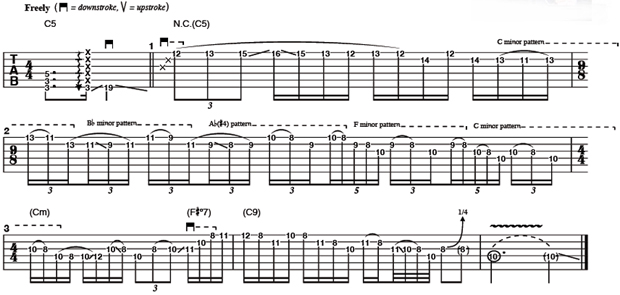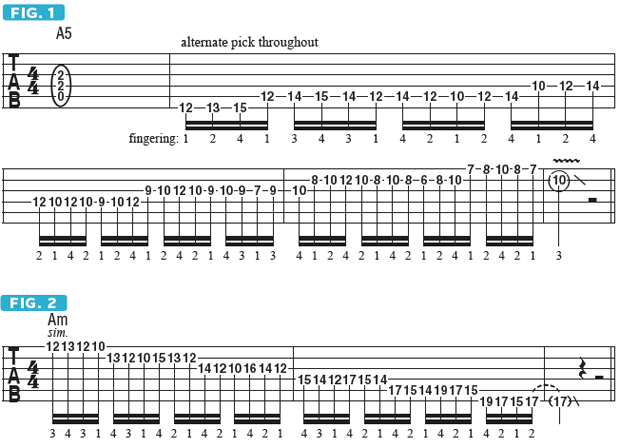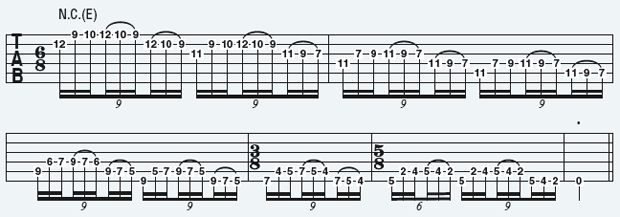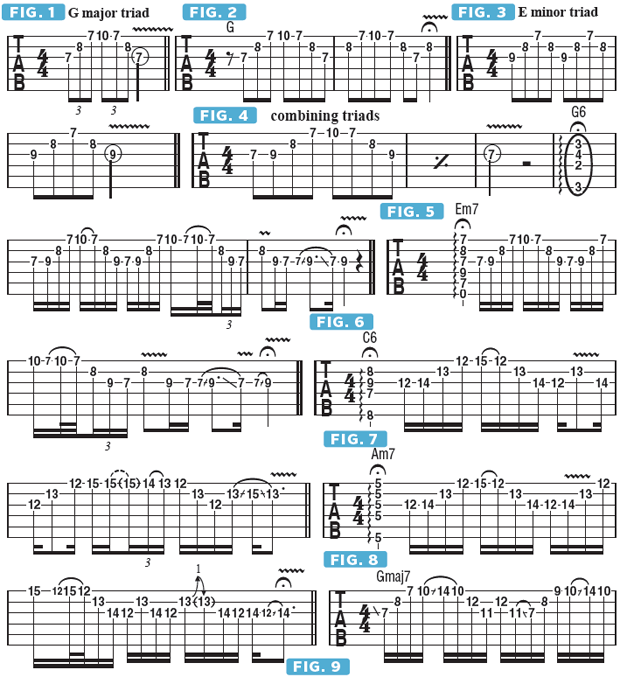Guitar World Year in Review: The Top 10 Guitar Lessons of 2014

With 2015 about to kick in (in, like, just a few hours), Guitar World is taking a nostalgic look back at the most popular GuitarWorld.com stories of 2014, including viral videos, guitar lessons and other features.
Be sure to check out our other 2014 Year in Review stories HERE!
Today, we're revisiting the 10 most popular guitar lessons on GuitarWorld.com, as determined by page views.
Even though it's a best-of piece, you'll still find a fine assortment of useful lessons here—everything from Betcha Can't Play This videos by Marty Friedman and Dream Theater's John Petrucci, not to mention two lessons by Steve Stine of LessonFace. There are some wordy pieces in here, which are balanced out nicely by a few very quick-hit video lessons. But you probably won't be able to miss the fact that our 2014 list is dominated by Petrucci, who happens to be a natural teacher!
Remember you can read the complete lessons by clicking on the READ THE FULL LESSON HERE link at the bottom of each page. Also note that, just because these were our top 10 lessons of 2014, several of them were actually posted prior to 2014 (like the Friedman video, for instance).
Anyway, see you in 2015! Remember to practice! We're serious!
10. Betcha Can't Play This: Marty Friedman Explores the Phrygian-Dominant Mode by Marty Friedman
All the latest guitar news, interviews, lessons, reviews, deals and more, direct to your inbox!
Here's a fast one one that mostly uses the Phrygian-dominant mode. It’s in the key of C. I start with a C power chord as a pickup to the first bar. Sometimes I like to include another fifth below the chord itself.
This brings out overtones that give the illusion of a lower root note, especially when you’re using heavy distortion. Even though the tempo marking is shown as "Freely," the lick is meant to be played as fast as you can.
So in bar 1, I ease into it by starting off relatively slow and move into full speed by the third beat, sort of what it would sound like if a snowball started rolling down a steep hill and got larger and faster on the way down. I like the Phrygian-dominant mode because of its exotic Eastern flavor; you can also think of it as a harmonic minor scale, which in this case would be in the key of F and starts on the fifth scale degree (C).
Notice how I play most of bar 1 legato—there’s nothing wrong with making it easy on yourself. At the end of bar 1 going into bar 2, I go into a series of five sextuplet patterns that gradually descend the neck. The fretboard shapes are a bit more familiar—the first two are minor (C minor and Bb minor), the third is major with an added #4—Ab(#4)—and the last two return to minor (F minor and C minor).
“By the time I get to the third bar, the C minor tonality is firmly established and I riff all the way through until the last beat, where I downward sweep a quick F#• arpeggio (I upstroke the seventh at the end). I use this to lead into the end, which is a bluesy run based on C9 and incorporates the very familiar blues box pattern.”

09. Wild Stringdom with John Petrucci: Moving Across the Fretboard in Unusual Ways to Produce Unique Runs by John Petrucci
Over the years, people have noticed that when I play certain runs, my fingers move in the opposite direction of the notes that they hear.
For example, as my fret hand moves up the fretboard, the sequence of notes that is heard descends (and vice versa). For this month’s column, I’ve put together a few runs that demonstrate this unusual approach as applied to both ascending and descending patterns.
This kind of “positional wizardry” can be used to generate interesting melodic patterns that can be used in a variety of ways.
In FIGURE 1, I begin on the low E string in a high fretboard position and end on a high string in a lower position. The run is based on the A Aeolian mode (A B C D E F G), which is also known as the A natural minor scale and is intervallically spelled 1 2 b3 4 5 b6 b7.
The overall concept behind this line is a consistent progression of six-note groups, or “cells,” that move to different areas of the fretboard while remaining diatonic to (within the scale structure of) A Aeolian. The run is played in a rhythm of even 16th notes, which, due to its inherent four-note grouping, results in a more unusual melodic “shape” than if I had played the pattern in a triplet or sextuplet rhythm.

08. Soloing Strategies: Randy Rhoads' Scales, Blues Licks and Daring Chromatic Maneuvers by Tom Kolb
In the world of heavy metal, hot guitarists are a dime a dozen.
Yet only a precious few stand the test of time and become enduring guitar gods.
Randy Rhoads was one such player. Joining forces with singer Ozzy Osbourne in 1979, Rhoads burst onto the metal scene like a bolt from the blue.
He was blessed with dazzling chops and an innate comprehension of music theory, and his style had a perfect blend of flash and melodic structure.
Flowing legato sections segued to impossibly fast, palm-muted picking passages; incendiary trills and daring chromatic maneuvers coexisted with classically influenced melodies—all of which were derived from a seemingly inexhaustible supply of scales and arpeggios and laid out across an ever-shifting rhythmic landscape.
What's more, Rhoads was so precise that he could seamlessly double-track anything he played, for maximum sonic density.
Sadly, only three recordings—Blizzard of Ozz, Diary of a Madman, and Tribute—captured Rhoads' genius before a tragic airplane crash, in 1982, cut his life short. But the musicianship that lies within those grooves is as stunning and inspirational today as it was then.
Sequences and Scales
Rhoads would often sprinkle a solo with a flurry of pentatonic pull-offs such as those in Fig.1. Built from the A minor pentatonic scale (A-C-D-E-G), this lick is inspired both by the opening moments of the first solo in "Mr. Crowley" and by the fill just before the last verse of "I Don't Know." It's interesting to note that while Rhoads possessed the facility to rip through lines such as these using alternate picking, he often chose a legato approach for a smoother, more flowing outcome.

07. Three Steps to Shred: Fundamental Daily Practice Techniques in About 15 Minutes by Steve Stine
No matter your level of experience, being a guitarist involves pushing your personal boundaries with the instrument.
Many players find themselves struggling to develop the physical abilities needed to play like their heroes, and, crucially, they never settle on a consistent set of exercises because they find themselves drowning in so many different suggestions.
In this column and video, I discuss some straightforward, essential practice techniques you can work into a simple, short daily routine to improve your dexterity, speed, strength and stamina to help you overcome obstacles and become a better guitar player.
These practice techniques are broken into three sections: 01. Picking hand: two three-minute exercises; 02. Fretting hand: a series of 15- or 20-second strength exercises; and 03. Both hands: a symmetrical exercise emphasizing synchronization between the left and right hands.
All in all, these exercises should take about 15 minutes. My students have found that, when done faithfully and properly, they yield significant positive results. Please note that it's a good idea to stretch out your hands, wrists and arms for a few minutes before doing these exercises.
06. Guitar Strength: Seven Habits That Will Make You a Better Guitarist by Scott Marano
Like the headline says, here are seven habits — habits you'll need to get into — that will, simply put, make you a better guitarist.
01. Visualize: You don’t just have to practice when there’s a guitar in your hands. There’s plenty of time in the day being wasted that you can use to improve your playing. Whenever you have a spare few seconds to daydream or are zoning out in class or at a meeting or waiting in line at the DMV, etc., use the time to go inside your mind’s eye and ears and visualize yourself perfectly executing the lick, riff or song you’ve been working on.
See and hear yourself playing the part with an expert ease, gliding as one with the strings, “virtually” feeling your fingers and your pick in precise synchronization. Repeat this whenever you can and you’ll find you’re better than you were before the last time you picked up the guitar and that the experience of the real guitar in your hands is enriched for the process.
An added bonus of this is that when you get better at connecting the disparate experiences of the imagined and the real, you’ll find that the accuracy of translating what you hear in your head through your fingers to the fretboard will significantly improve, as will your ability to transcribe things you hear while away from your guitar (if nothing else, you’ll be floored at how realistic your air guitar playing will be!).
02. Learn Something New Every Day: This is one of the easiest things you can do to enrich your guitar playing, musicianship and, most importantly, your discipline and motivation. Simply put, find one guitar-related thing a day that you didn’t know already and learn it. And play it. It can be a riff, a lick, a chord, a scale, an exercise, a song, a melody, an altered tuning, a strum pattern, the part of a song you know all of the cool riffs of but never bothered to learn the “boring” connecting transition sections of, whatever.
The discipline of seeking out, playing and internalizing a new piece of guitar knowledge on a daily basis will feed your subconscious musical instincts, add new concepts to your muscle memory and ultimately aid in your ability to express yourself and perform effortlessly on the guitar.
Make this a part of your day and you’ll find that as you continue on your journey, one thing will become two, then three, and on and on until you are devouring as much as you can absorb on the guitar, every day!
05. Big Strokes: A Beginner's Guide to Sweep Picking by Charlie Griffiths
Although often regarded as a “shredder’s” technique, the notion of sweeping (or raking) the pick across the strings to produce a quick succession of notes has been around since the invention of the pick itself.
Jazz players from the Fifties, such as Les Paul, Barney Kessel and Tal Farlow, would use the approach in their improvisations, and country guitar genius Chet Atkins was known to eschew his signature fingerstyle hybrid-picking technique from time to time and rip out sweep-picked arpeggios, proving that the technique is not genre specific.
Within rock, Ritchie Blackmore used sweep picking to play arpeggios in Deep Purple’s “April” and Rainbow’s “Kill the King.”
Fusion maestro Frank Gambale is widely considered to be the most versatile and innovative sweep picker and the first artist to fully integrate the technique into his style, applying sweeping to arpeggios, pentatonics, heptatonic (seven-note) scales and modes, and beyond.
Gambale explains his approach wonderfully in his instructional video, Monster Licks and Speed Picking. Originally released in 1988, it remains a must-watch video for anyone interested in developing a smooth sweep-picking technique.
It was Stockholm, Sweden, however that would produce the name most synonymous with sweeping in a rock context, one that gave rise to a guitar movement known as neoclassical heavy metal.
Swedish guitar virtuoso Yngwie Malmsteen was influenced by Jimi Hendrix, Ritchie Blackmore and Uli Jon Roth but was also equally enthralled by 19th-century virtuoso violinist Niccolò Paganini. Attempting to emulate on his Fender Stratocaster the fluid, breathtaking passages Paganini would compose and play on violin, Malmsteen concluded that sweep picking was the perfect way to travel quickly from string to string with a smooth, fluid sound much like what a violinist can create with his bow.
Malmsteen’s style has since influenced two generations of guitarists, including Tony MacAlpine, Jason Becker, Steve Vai, Mattias “IA” Eklundh, Ritchie Kotzen, Marty Friedman, John Petrucci, Vinnie Moore, Jeff Loomis, Synyster Gates, Alexi Laiho and Tosin Abasi, to name but a few.
The first five exercises in this lesson are designed to give you a systematic approach to practicing the component movements of sweep picking: from two-string sweeps to six-string sweeps, and everything in between. Practicing each exercise with a metronome for just two minutes every day will improve your coordination and your confidence to use the technique in your own playing.
Work from two strings up to six, keeping your metronome at the same tempo. This means starting with eighth notes, and while this will feel very slow, the technique will become trickier with each successive note grouping: eighth-note triplets, 16th notes, quintuplets and, most difficult of all, 16th-note triplets and their equivalent sextuplets.
Focus on synchronizing your hands so that your pick and fretting fingers make contact with the string at exactly the same moment. Only one string should be fretted at any time (this is key!), and any idle strings should be diligently muted with your remaining fingers.
If you fail to do this and allow notes on adjacent strings to ring together, it will negate the desired effect and sound like you are simply strumming a chord. When it comes to sweep picking, muting is the key to cleanliness. It is also the aspect that will take the most practice to master.
The second set of five exercises handles some common sweep-picking approaches. These are shown in one position and based on one chord type each, thus focusing your attention on the exercise until you have become accustomed to the technique.
The final piece helps you tackle the various aspects of sweeping while bolstering your stamina, as the bulk of it consists of nonstop 16th notes, with only a few pauses for “breathing.” Break it down into four-bar sections and practice each with a metronome, gradually building up to the 100-beats-per-minute (100bpm) target tempo.
Get the Tone
In rock, this technique is best suited to Strat-style guitars, using the neck pickup setting for a warm, round tone. Use a modern tube amp with the gain set to a moderate amount—just enough to give all the notes a uniform volume and sustain, but not so much that string muting becomes an impossible battle.
The thickness and sharpness of your pick will hugely impact the tone of your sweep picking. Something with a thickness between one and two millimeters and a rounded tip will provide the right amount of attack and still glide over the strings with ease.

04. Betcha Can't Play This: John Petrucci's Descending E Mixolydian Run by John Petrucci
This is a descending E Mixolydian [E F# G# A B C# D] run that moves across the strings and eventually down the neck in a cascading type of contour.
It’s based on a recurring nine-note melodic motif of three 16th-note triplets, with three alternate-picked notes followed by two double pull-offs.
I begin in ninth position with a fairly compact shape that spans the ninth to 12th frets. At the end of bar 1 and moving into bar 2, the fret hand shifts down two frets and spreads out to cover a four-fret span, from the seventh fret to the 11th. Use your first, second and fourth fingers to fret the notes.
The fret hand quickly shifts down to a lower position at the beginning of bars 3, 4 and 5, so try to make these transitions as smooth and seamless as possible. Make sure your pull-offs are loud and clear, and use the palm of your pick hand to mute the unused lower strings during bars 1 and 2.

03. Wild Stringdom with John Petrucci: Using Triad Arpeggios to Imply More Complex Chord Qualities by John Petrucci
This month, I’m going to demonstrate how one can utilize simple triadic shapes and patterns in order to imply more complex and varied chord qualities.
I find this to be a very cool and useful improvisational tool, because you can apply it to playing over either a chord progression that you want to outline melodically or over a static pedal tone or one-chord vamp over which you want to superimpose shifting harmonic colors.
Let’s begin by outlining, and then combining, simple major and minor triads. FIGURES 1 and 2 illustrate the notes of a G major triad—G B D—played in seventh position. The relative minor triad of G major is E minor, and FIGURE 3 depicts an E minor triad played in the same position. Notice that both triads share two of the same notes, G and B.
The “magic” happens when we combine these two triads, and we can utilize and analyze the resulting sound within either a G major or an E minor context. FIGURE 4 shows the two triads combined, so in essence we’ve simply added the E note to the G major triad.
Adding E, the sixth of G, implies the sound of a G6 chord. If we play the same pattern over an E minor tonality, the resultant chordal implication is Em7, as shown in FIGURE 5, and the single-note triadic-based phrases evoke a different harmonic impression.
Let’s now apply this approach to a different tonal center. As shown in FIGURES 6 and 7, the combination of the notes of a C major triad—C E G—and an A minor triad—A C E—result in either a C6 sound, as shown in FIGURE 6, or an Am7 sound, as shown in FIGURE 7. The beauty of this exercise is that it demonstrates how the study of one theoretical concept and its associated single-note patterns can easily be applied to more than one tonal environment.
On a grand scale, this means that the study of one idea can be applied to many different harmonic environments, yielding a broader understanding of music theory as well as heightening one’s fretboard awareness.
- Another great way to use this concept is to combine two different triads that are found within the same tonal center. For example, within the G major scale (G A B C D E F#), one can build a series of seven different triads by starting from each note in the scale and adding thirds above the starting note while remaining diatonic to (within the scale structure of) G major. If we start from B, the third degree of the G major scale, a B minor triad is formed by playing B D F#, notes that
- are all thirds apart, as they occur within the G major.
FIGURE 8 illustrates a phrase that combines G major and B minor triads. We can then apply this approach to the relative minor of G, Em7, as shown in FIGURE 9. When looked at as a whole, combining G major and B minor triads implies a Gmaj13 chord, as shown in FIGURE 10.

02. Essential Blues Basics: Soloing with the Combined Minor/Major Pentatonic Scales by Steve Stine
Steve Stine, highly sought-after guitar educator, teaches live group and private classes at LessonFace.com.
One key to becoming a more versatile blues soloist is learning to combine the minor pentatonic and major pentatonic scales to create guitar lines that go beyond the minor pentatonic scale.
As a prerequisite to this lesson, you should have a basic understanding of the finger positionings for the minor pentatonic and major pentatonic scales, particularly the first and second positions of both scales.
Stepping back, I should note that learning to play within both of these scales at the same time opened new doors for me as a guitar player.
Before combining them, I remember first learning to solo over the standard 1-4-5 blues progression, and my teacher at the time gave me a quick trick for alternating between the minor and major pentatonic solos: Use the minor pentatonic for the sections on the “1” and the major pentatonic for the sections on the “4," and alternate back in forth in this manner in the way that sounded best.
While this approach can work to give you a more varied sound beyond merely the minor pentatonic scale, this trick is by no means a hard and fast rule, and moving beyond it to learn to combine both scales makes you a more versatile player.
A quick point of reference to understand about these scales is that, in respect to physical finger positioning, they are identical, with one scale simply falling three frets below the other on the fretboard. That is to say, in any given key: (i) the finger position for the major pentatonic scale falls three frets down from the minor pentatonic scale, and (ii) the root note is the same for both scales.
So, for example, let’s focus on the key of A. The A on the fifth fret of the first string is the root note of both the A minor pentatonic and A major pentatonic scales. This means that, in the A minor pentatonic scale’s first position, the A on the fifth fret of the first string is played with your index finger.
01. The Scale That Will Change Your Life by Adrian Galysh
A number of years ago, I was teaching at a guitar workshop in Pittsburgh.
I had taught at this annual workshop a number of times and always looked forward to my week there, not only because I was able to teach a class of students who really wanted to learn guitar, but also for more selfish reasons. I liked meeting and learning from some of the other instructors and clinicians.
So during this week, jazz guitarist Henry Johnson and I were jamming on each other's guitars, and I took the opportunity to ask him, "Hey, how can I, as a rock guitarist, get that 'outside' jazzy/Alan Holdsworth-y sound?"
His answer was so simple and astonishing. I will share it with you here.
He said, "Simply flatten the root of the minor pentatonic scale. Use this whenever you would use the normal minor pentatonic scale."
The concept was simple but profound. I spent a few days getting the new shape under my fingers, and before I knew it, I was slipping this into every solo I could!
The example below shows the new altered A-minor pentatonic scale. In this A-minor example, this "flattened root scale" sounds outside over Am or an A7 chord, but inside over the dominant V chord (E7).

Since 1980, Guitar World has been the ultimate resource for guitarists. Whether you want to learn the techniques employed by your guitar heroes, read about their latest projects or simply need to know which guitar is the right one to buy, Guitar World is the place to look.

